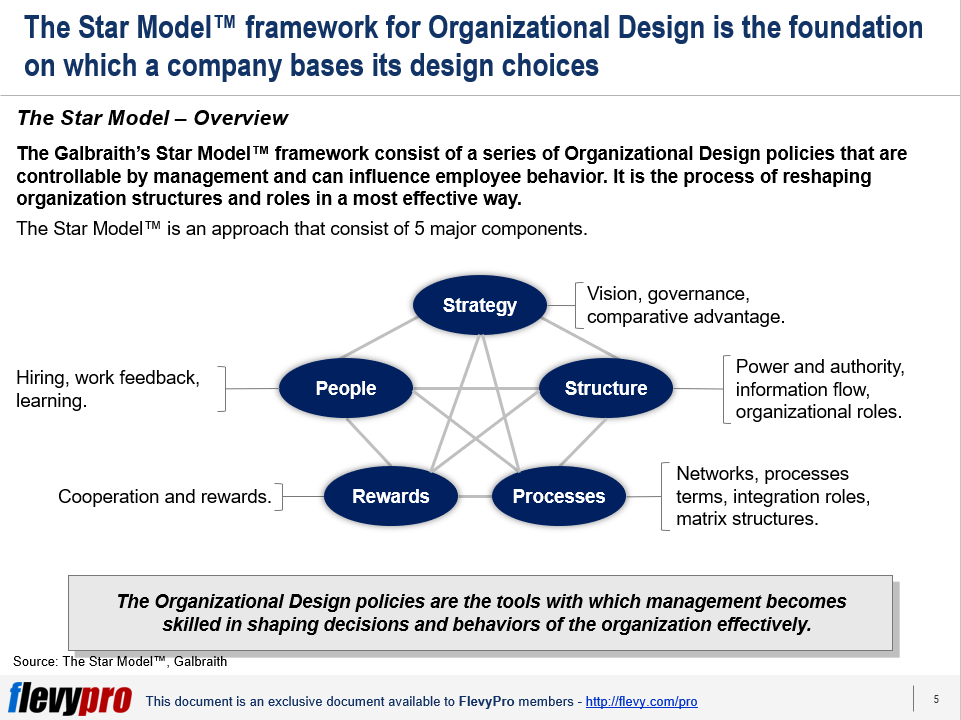“A problem well framed is a problem half-solved.” — Jay Galbraith
Organizational Design is more than just structures. It is having policies and strategies that are aligned with one another. When this is achieved, it allows organizations to operate at maximum efficiency and achieve Operational Excellence.
The Galbraith Star Model™ is the foundation on which a company bases its design choices. The organization’s design framework consists of a series of design policies that are controllable by management and can influence employee behavior.
Organizations use the Star Model™ framework to overcome the negatives of any structural design. Every organizational structure has positives and negatives associated with it. If management can identify the negatives of its preferred option, it can better design other policies around the Star Model™ to counter the negatives while achieving the positives.
Understanding the Galbraith Star Model™
Galbraith Star Model™ is the organization’s design framework for effective strategy execution. It consists of 5 major components.
- Strategy. This component is the company’s formula for winning. It is the goals and objectives to be achieved, as well as values and missions to be pursued. It defines the basic direction of the company. Strategy Development is essentially important in specifying sources of Competitive Advantage.
- Structure. The second component, the Structure, determines the location of the decision-making power. It is the placement of power and authority in the organization.
- Processes. Information and decision processes is a component that cuts across the organization’s structure. It is a means of responding to information technologies. Management processes can either be vertical or lateral. Either way, these are designed around a workflow from new product development to the fulfillment of a customer order. If the structure is the anatomy of the organization, processes are its physiology or functioning.
- Rewards. The fourth component provides motivation and incentive for the completion of the strategic direction of the organization. Rewards are recognition that influence the motivation of people to perform and address organizational goals. It becomes effective only when they form a consistent package in combination with other design choices.
- People. People is the fifth component that focuses on influencing and defining an individual’s mindset and skills. It looks into the human resource policies of recruiting, selection, training, and development of people needed by the organization to achieve its strategic direction. HR policies work best when these are consistent with the other connecting design areas.
The five components are essentially important. Each component has its underlying purpose and impact. How the organization can effectively align the components with each other makes a huge difference in achieving an impact. Further, in this fast-changing business environment, organizations must be keenly aware of the implications of implementing the Star Model™ framework. The Star Model may have its implications, including the interweaving nature of the lines that form the star shape.
The Man Behind the Organizational Design Framework
Dr. Jay Galbraith was an internationally recognized expert on Strategy and Organizational Design. With more than 45 years of research and practical experience, Dr. Galbraith’s extensive knowledge came from his background in information processing systems, chemical engineering, and organizational behavior. As the original creator of the Star Model and the Front-Back organization structure, Dr. Galbraith transformed organizations across a broad span of industries including consumer goods, manufacturing, health care, financial services, and telecommunications, among others.
Interested in gaining more understanding of Galbraith Star Model™? You can learn more and download an editable PowerPoint about Galbraith Star Model™ here on the Flevy documents marketplace.
Are you a management consultant?
You can download this and hundreds of other consulting frameworks and consulting training guides from the FlevyPro library.

Comments